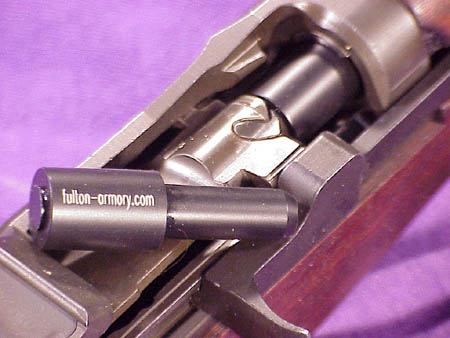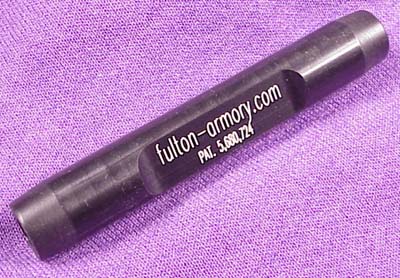 |
It's the Little
Things - Small Accessories with a Big Impact
~ Fulton Armory M1/M1A and AR-15 Dry Fire Devices ~ ~ Clymer Machine .308 Winchester "Field" Gauge ~ |
 |
|
|
|
|
CRUFFLER.COM
presents
ACCESSORY
REVIEW,
October
2000:
 |
It's the Little
Things - Small Accessories with a Big Impact
~ Fulton Armory M1/M1A and AR-15 Dry Fire Devices ~ ~ Clymer Machine .308 Winchester "Field" Gauge ~ |
 |
It's often the most overlooked small items that can have a dramatic impact. For example, just keeping your tires inflated to the proper pressure can improve your car's handling, make the tires last longer (unless, apparently, they're Firestones and you own an Explorer), and improve your gas mileage. Similarly, an inexpensive set of hollow ground screwdrivers can make all the difference between marred and damaged screws and metalwork and a perfect result. This month we're going to look at a pair of products that, while geared to very specific segments of the shooting public are nevertheless wonderfully useful, and inexpensive enough so that it's hard to justify NOT buying one!
FULTON ARMORY M1/M14/M1A and AR-15/M16 DRY FIRE DEVICES
 |
 |
|
|
|
Background
The single
most difficult riflery skill to perfect is shooting is the offhand, or
standing, unsupported position. More than any other, this type of
shooting tests the rifleman's ability to combine recognition of the proper
sight picture (with the sights in a state of constant motion), timing,
and proper trigger squeeze. It is not an easy skill to acquire,
and one that is quite perishable, requiring constant practice to maintain.
Problem is, most of us don't have the 24 hour access to a rifle range,
or the disposable income to devote to the considerable expense in ammunition
that such practice requires. Fortunately, neither do most high power
service rifle competitors, whose sport requires significant offhand shooting
ability. If you ask a successful competitor how he or she manages
to maintain their offhand shooting skills as well as a full time job (unfortunately
there is no National Endowment for Competitive Shooting. . .yet), they
will look at you, and in a conspiratorial tone, whisper two words:
"Dry Firing."
By devoting as little as 30 minutes a day to dry firing a given rifle at a small black dot (1/4" to 1/2" in diameter - the waste products from most three hole punches are ideal) on the opposite wall of a room, a shooter can acquire and maintain the offhand shooting skills necessary to compete successfully. This requires that the shooter use (in the interests of marital comity, the maintenance of a respectful distance from the local criminal justice system, and structural longevity of one's dwelling) an unloaded rifle. The rifle is then cocked, aimed at the aiming point on an opposite wall, and dry fired. The cycle is then repeated.
The difficulty here comes in recocking the arm after each shot. For the M1/M1A or AR-15 style rifles that are most commonly used in service rifle competition, this operation requires the rifle to be lowered, the sight picture disrupted, and a new cheek to stock weld acquired for each shot. Not only is this unrealistic (these rifles are self loaders and would be fired as such in competition), but it lessens the training value of the dry fire practice, as well as the number of shots that can be taken in a given time period.
Enter the wizards
at Fulton Armory. Fulton
Armory is a full service gunsmithing shop located in Savage, Maryland that
is dedicated solely to general issue United States military self loading
shoulder arms (and their civilian analogs), including the M1 Garand rifle,
the M1 carbine, the M14 (M1A) rifle, and the M16 (AR-15) rifle.
The shop's owner, Clint McKee, has been building, tuning, accurizing, and
repairing these rifles, in all their incarnations, from match to "rack"
grade, for almost 20 years. In addition to rifles and gunsmithing
services, Fulton Armory also sells a complete line of parts, tools, and
accessories for these rifles at very competitive prices, and often will
spend great amounts time providing advice to customers and potential customers
alike. It is no small wonder that when William H. Peterken contacted
Clint with a design for an AR-15 dry-fire device, Clint was quick to work
with him to solve the dilemma faced by the competitive shooter when conducting
dry fire practice.
Physical
Examination and Use
What Mr. Peterken
came up with (seen in the photos above) are specialized tools for both
the M1/M14 and AR-15 rifles that permit the shooter to dry fire the guns
with a minimum of effort and movement needed to recock the arm between
shots. The tools have the added bonus of serving as safety devices,
as they ensure that no live ammunition can be fired from the rifle when
installed. Each device is constructed of sturdy black ABS plastic
for years of use and finished to exacting tolerances. Use of the
devices is simple and easy, requiring no modifications to the firearm and
seconds to install:
M1/M14
1. Ensure that the firearm is unloaded.AR-15
2. Ensure that the firearm is unloaded.
3. Pull the operating rod/bolt fully to the rear.
4. Insert the smaller diameter portion of the device into the chamber as far
as it will go.
5. Ease the operating rod/bolt forward until the raised portion at the rear of
the device seats in the recessed portion of the boltface.At this point, the rifle may be dry fired with impunity, the bolt needing to be retracted a mere 1/8" to 1/4" to recock the mechanism.
1. Ensure that the firearm is unloaded.Evaluation
2. Ensure that the firearm is unloaded.
3. Pull the charging handle fully to the rear and ride it fully
forward.
4. Punch the rear locking pin out and break the firearm open with the
forward push pin serving as a fulcrum.
5. Insert the device into the rear of the bored out bolt carrier with the
scalloped (lettered) portion of the device facing toward the bottom of the
receiver. Seat it fully so that the upper and lower receiver can
close.At this point, the rifle may be dry fired with impunity, the charging handle needing to be retracted a mere 1/8" to 1/4" to recock the mechanism.
We tested the devices for ease of use, rapidity (i.e., how many more times could we dry fire the gun in within a given period of time), and durability. All tests were done by a right handed shooter of average size and reach.
|
|
|
|
|
|
|
|
|
|
CLYMER
MACHINE .308 WINCHESTER "FIELD" HEADSPACE GAUGE
 |
Background
We're not ashamed to admit it. While some people have photos of actors, statesmen, or even swimsuit models on the wall in their bedrooms, we have a |
This is all a long, roundabout way of saying that we really like the FAL rifle. Like any true fans, we like to know all the minutiae about the gun, to include all the critical dimensions. Among these is the headspace dimension. Headspace dimensions on rifles chambered for the 7.62mm NATO cartridge can be misleading. As a case in point, military FAL headspace dimensions are not identical to those of the dimensionally similar .308 Winchester cartridge. For comparison's sake, a rifle chambered for the .308 Winchester should have a minimum chamber length of 1.630", which equates to the .308 Winchester "GO" headspace gauge. A new rifle chambered for the .308 Winchester should have a headspace dimension no larger than 1.634" - the same length as the .308 Winchester "NO-GO" headspace gauge. Finally, a .308 Winchester rifle that has seen use should be considered unserviceable if the chamber dimension is larger than 1.638" - the length of a "FIELD" headspace gauge. The FAL, on the other hand, has a minimum chamber length of 1.6315" and a maximum chamber length of 1.640."
For some strange reason, FN didn't see it necessary to consult the US based Sporting Arms and Ammunition Manufacturer's Institute (SAAMI) when determining headspace dimensions for the FAL. As a result, it is very possible, when using solely .308 Winchester gauges, to make the determination that an FAL has excessive headspace when in fact it is perfectly serviceable FOR THE MILITARY 7.62MM NATO AMMUNITION FOR WHICH IT WAS DESIGNED. We added emphasis for a very good reason. If you choose to fire commercial .308 Winchester in an FAL, then the .308 headspace specifications are controlling. In other words, an FAL with a headspace dimension of 1.639" is considered to be unserviceable and unsafe with .308 Winchester ammunition, but perfectly serviceable with 7.62mm NATO military ammunition.
Evaluation
Now we come
to the real issue - since most commercially available headspace gauges
for the .308 Winchester include a maximum length of only 1.638", how does
an FAL enthusiast know whether his rifle is within specification for military
7.62mm NATO ammunition? The answer can be had in the pages of the
Clymer
Manufacturing Company's catalogue. Located in Rochester Hills,
Michigan, the Clymer Manufacturing Company was started in 1958, and continues
to provide high quality gun tools to both the professional gunsmith and
hobbyist. Among Clymer's products are chambering and finishing reamers
as well as headspace gauges.
For the FAL-minded among you, Clymer also offers a.308 Winchester "Field" headspace gauge of 1.640" in length. FAL enthusiasts that we are, we immediately ordered this tool, so that our FAL gauge set would be "complete." It arrived a few days later. The gauge is finished bright, with only the barest evidence of machining marks on the tapered portion of the gauge. It is carefully marked:
CLYMER 998
(this is a date code meaning that the gauge was made in September, 1998)
308 WIN
FIELD
The gauge boasts a wide, well cut extraction cannelure and a deep firing pin recess. There is also a cut-out in the rim. While this was originally done so that the gauge could be driven on a cylindrical grinder (an "O.D" grinder), it neatly doubles as an ejector cut out for rifles with plunger type ejectors. We found the cut out to be too narrow to permit the extractor on an FAL to slip through it.
The gauge is as well made and finished as any tool we've seen. It fit smoothly into the chambers of three different FAL's, an M1A, and a commercial .308 Winchester hunting rifle with no hint of binding. We immersed the tool in solvent for 24 hours to see if the markings would disappear. They didn't. All in all, we were well pleased with the gauge.
Conclusion
If you are
an FAL hobbyist, enthusiast or gunsmith, we believe that at $25.00, the
Clymer .308 WIN "Field" gauge is a must have item. However, we again
caution the reader to remember that headspace specifications are for a
gun/ammunition combination. Just because the factory specification
for FAL headspace is 1.640" maximum, this does not mean that an FAL which
will not close on a 1.640" gauge is safe to fire with commercial .308 Winchester
ammunition. Be sure of both your gun and the ammunition for which
it is chambered. Be safe. After all, you wouldn't be investing
in gauges if safety wasn't a prime concern!
And now, our Buy-O-Meter rating for these products:
Fulton Armory Dry Fire Devices:
 |
Clymer 1.640" .308 Winchester "Field" Headspace Gauge:
 |